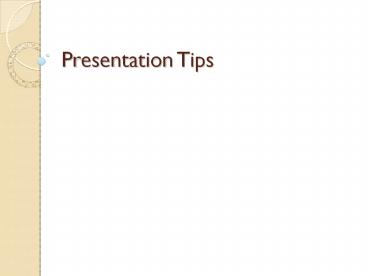Presentation Tips - PowerPoint PPT Presentation
1 / 25
Title: Presentation Tips
1
Presentation Tips
2
185 Presentation
- Maximum length 6 minutes.
- Pay attention to two minute and one minute
warnings. - Followed by a 2 minute question and answer
session.
3
A Technical Subject
- A little vague, isnt it?
- Basically, describe a process.
- If youre not sure if your topic is technical
enough, ask.
4
Past Topics
- Constructing Germanium Nanowires
- How to detect and prevent cheating in online
games - Path planning for multiple robots moving in
formation - Eyeglass lens manufacture
- How to build the frame of a house
- Establishing a wireless network in a rural
setting using Satellite DSL - The physics of automotive drift
- Rendering realistic 3D landscapes
- Artificial intelligence routines for Texas Hold
'Em - Quality Assurance Testing.
- Collision detection in real-time multiplayer
games - Plotting graphs using Microsoft Excel
- How does BitTorrent work?
- Using Maya animation software
5
Basic Presentation Skills
- Voice
- Body Language
- Appearance
6
Voice
- Volume
- Speak loudly enough for the back end of the room.
- Dont shout or whisper.
- Speed
- Speak naturally.
- Dont rush, or speak too slowly.
7
Breathe.
- Practice deep breathing.
- Breathe slowly and deliberately.
- Practice delivering a single musical note for as
long as possible. - Extra credit Study meditation techniques.
8
- Pronounce words clearly
- Enunciate consonants
- D-T
- G-K
- L-R
- B-P
- He stood on the balcony, inexplicably mimicking
him hiccuping, while amicably welcoming him in.
9
Body Language
- Face the audience.
- If you must turn away, do so briefly.
- Dont hide behind the podium.
- Keep your body open to the audience.
10
- Body language always says something.
- Whether you mean it to or not.
- You can look formal, or casual.
- Or stiff, or sloppy.
- Always look aware and awake.
11
Hand Gestures
- Keep hand gestures clear.
- Point distinctly.
- Use clean hand gestures.
- Try not to wave your hands needlessly.
12
Appearance
- Dress for the occasion.
- What are others wearing?
- What do you feel comfortable in?
- What you wear can effect your attitude.
- When in doubt, err on the side of over-dressing.
13
Preparation
- Outline the main objectives of the presentation.
- Always know your opening line.
- Follow your outline, dont read from a script.
14
- Rehearse in front of a mirror.
- Rehearse in front of your peers.
- Rehearse in front of anyone wholl watch.
- Use feedback constructively.
15
PowerPoint/Slide Presentations
- Useful, but frequently troublesome.
- Use slides to prompt points of discussion, not as
your script. - Dont cram too much onto one page.
- Two or three bullet points per page is usually
enough.
16
- Use clear graphics.
- Will they make sense to a non-expert?
- Are they large enough?
- Will they still be clear when projected on a
screen? - Do they contain more information than you can
cover?
17
Presentation Structure
- Greet the audience.
- Introduce yourself.
- Keep your introduction short.
- Tell the audience what they need to know about
you. - Introduce your subject.
- Tell the audience what youre going to talk
about. - Then talk about it.
18
- Be prepared for questions.
- Answer what you can.
- Be honest about what you cant answer.
- Ask friends and colleagues in the audience to
help you out. - When in the audience yourself, help out your
friends and colleagues.
19
- Troublesome questions
- If an answer requires a lengthy response, offer
to talk after the presentation. - Be prepared for hostile questions.
- Maintain your composure.
- Sometimes the QA session turns into an
opportunity for commentary. - Be respectful of dissenting views.
- You are the moderator. Control the room.
20
Content
- Frame your message.
- Especially if it is legally or socially
controversial. - Dont directly advocate unethical actions.
- Be aware of your audience.
- But dont assume too much.
- Expect unexpected reactions from your audience.
21
- Selling your idea or product?
- Address the merits and limitations of your
subject. - Dont underestimate your audience.
22
Live Demonstrations
- Are you demonstrating how to use a program? A
tool? A process? - This is, for practical purposes, a performance.
- Rehearse each step.
- If possible, rehearse each step on the same
equipment, in the same space as your
presentation. - Leave as little as possible to chance.
- Be prepared for malfunctions have something to
say throughout. - Keep it simple. Its a demonstration, not a
lesson. - Class rule Nothing dangerous or foul-smelling,
please.
23
Humor
- Can be useful to deliver a point.
- But can backfire if the joke isnt funny.
- Choose appropriate material.
- Let the audience laugh - dont cut them off.
- What one group finds funny, the next may not.
24
Remember
- Your audience is not a group of professional
speakers. - They dont expect you to be perfect.
- They can sympathize with any nervousness.
- You can correct any minor mistakes as you go
along. - Check out the space beforehand.
- Examine the size, the seating.
- Look at the technical equipment.
- If possible, test it out beforehand.
25
- Practice.
- Practice.
- Practice.
- Beyond all else, convey your message.































